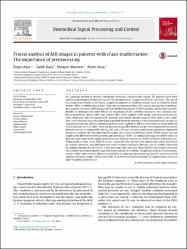Fractal analysis of MR images in patients with chiari malformation: The importance of preprocessing
Özet
As a popular method to meathe complexity of images and generally signals, FD analyses have been
used in neuroimaging studies to evaluate the morphological complexity of brain structures. The aim of
this study is to perform an FD-based complexity analyses of cerebellar tissues, such as cerebellar white
matter (WM), cerebellar gray matter (GM) and cerebrospinal fluid (CSF) spaces around the cerebellum,
on magnetic resonance (MR) images of Chiari Malformation type-I (CM-I) patients and healthy controls.
Besides, to determine the noise effects on complexity of sub cerebellar structures, two common nonlinear noise filters, median filter and bilateral filter, were applied to MR images and their performances
were compared. Data of fourteen CM-I patients and sixteen normal subjects were used in this study.
First, noise variance was estimated using a method based on skewness of the magnitude data. Second, as
a preprocessing step, median and bilateral filters were applied on MR data separately to create different
series of images for each filter. After the preprocessing, filtered brain images were segmented into three
different tissues including WM, GM and CSF. Last, a 3D box-counting method was applied on segmented
images to estimate the corresponding FD values. Our results showed that, while GM FD values was not
significantly different between patients and controls (p = 0.051) in median filtering case, GM FD values in
patients were found to be significantly lower than those in controls (p = 0.007) in bilateral filtering case.
Additionally, in both cases, WM FD values in patients were found to be significantly lower than those
in controls; however, this difference was more evident in bilateral filtering case (p = 0.0003) than that
in median filtering case (p = 0.013). These outcomes indicated that bilateral filter was found to be more
successful in discriminating CM-I patients from controls in cerebellar complexity analyses. In conclusion,
results of this study revealed that noise removal is an important preprocessing step for a more successful
analysis of digital images and bilateral filter is an effective filtering method for segmentation accuracy
and FD analysis performance.

















